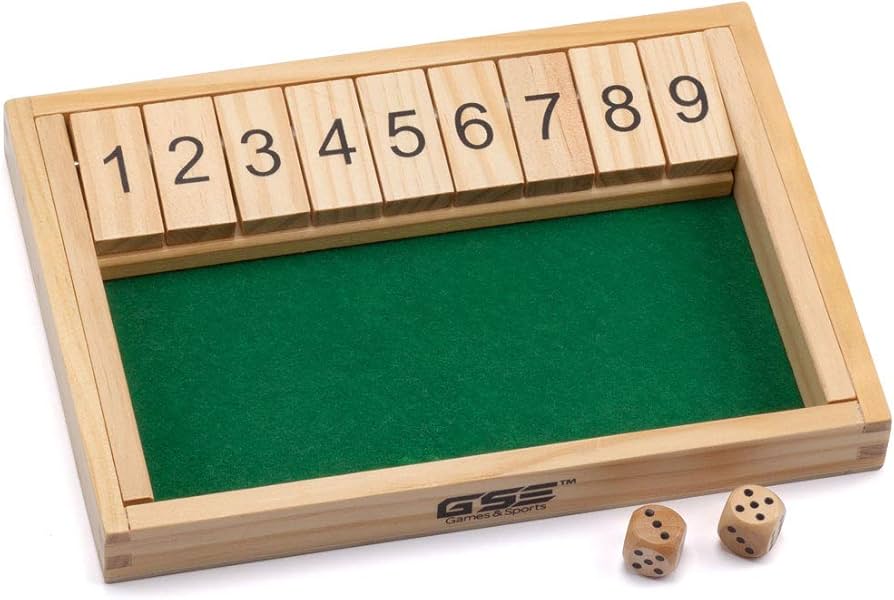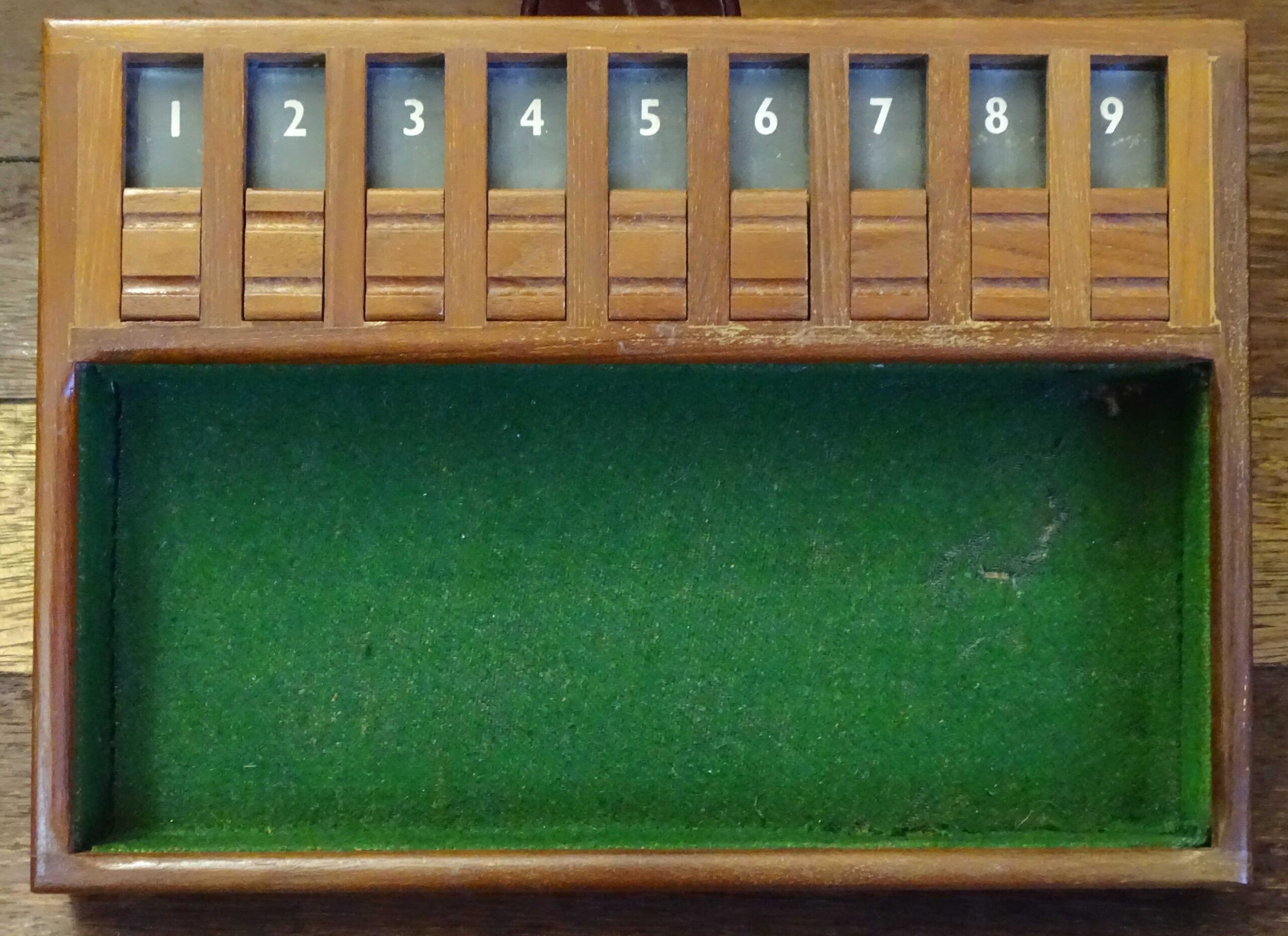Introduction
Shut the Box is a traditional dice game that has entertained generations with its blend of simple rules and strategic depth. Originating in European taverns centuries ago, this game remains popular today, often found in pubs, family game nights, and casual gatherings. Its charm lies in the seamless combination of chance and skill, making it accessible for beginners yet engaging for experienced players. This article explores the origins, gameplay, strategies, variations, and the enduring appeal of the Shut Box dice game.
Origins And History Of Shut The Box

The origins of Shut the Box are somewhat mysterious, but it is widely believed to have been invented in France or England sometime in the 12th to 14th century. The game was traditionally played by fishermen and sailors as a pastime during long sea voyages or after a day’s work. The name “Shut the Box” refers to the wooden box with numbered tiles or flaps that players attempt to close or “shut” during the game. The wooden design and the dice elements made it portable and easy to play anywhere. Over time, Shut the Box has become part of cultural heritage in many European countries, evolving with different rule variants while retaining its core mechanics.
Basic Equipment And Setup
Playing Shut the Box requires minimal equipment, making it an accessible game for all ages. The classic version includes a wooden box with numbered tiles from 1 to 9, although some versions extend the range to 12 or 18. Each tile flips down to cover the number and flips up when the number is open. The game also requires two dice, typically six-sided standard dice. The setup is straightforward: all numbered tiles start flipped up, and players take turns rolling the dice to close the tiles. Because of its simplicity, Shut the Box can be played on any flat surface, and the compact box design makes it easy to transport.
Objective And Gameplay Overview
The objective of Shut the Box is to close as many numbered tiles as possible based on the dice roll, thereby minimizing the numbers left uncovered. Players take turns rolling two dice, then “shut” or flip down one or more tiles that sum to the total of the dice roll. For example, if a player rolls a total of 8, they can flip down the tile numbered 8, or a combination such as 5 and 3, 6 and 2, or 4 and 4 if the tiles are still open. The turn continues as long as the player can make legal moves. The round ends when no more tiles can be closed to match the dice roll. The player’s score is the sum of the remaining uncovered tiles, with the lowest score winning. If a player shuts all tiles, they achieve a perfect game, often considered a “Shut the Box” and typically rewarded.
How To Play Shut The Box Step-By-Step?
Starting the game, each player rolls the dice to decide who goes first, usually the highest roll. On a player’s turn, they roll two dice and analyze which tiles can be flipped down to equal the dice total. The player may choose to flip a single tile or multiple tiles that add up to the total, offering strategic decision points. After flipping the tiles, if the player can still make moves with the remaining tiles matching the next dice roll, they continue. When the player reaches a point where no legal moves match the dice roll, their turn ends, and their score is tallied based on remaining tiles. The next player then takes their turn. Play continues for a predetermined number of rounds or until players decide to stop, with the lowest cumulative score declared the winner.
Understanding The Role Of Chance And Strategy
Although Shut the Box involves rolling dice, which introduces an element of chance, strategic choices greatly influence the outcome. Players must decide which combination of tiles to flip to maximize future options and minimize leftover numbers. For example, closing higher numbers early in the game can reduce potential leftover points, but preserving certain tiles might offer better combinations in subsequent turns. Balancing risk and reward, considering probabilities of dice rolls, and predicting possible moves add layers of strategy that elevate the game beyond pure luck. Skilled players often think several moves ahead and adjust their approach dynamically based on the state of the board.
Common Strategies To Improve Your Chances

One effective strategy in Shut the Box is to prioritize closing tiles that leave flexible options for the next rolls. Because the total dice roll ranges from 2 to 12, focusing on numbers that can be combined in multiple ways is advantageous. For instance, closing tiles like 7, 8, and 9 early can be beneficial as they can be combined with smaller numbers in many ways. Additionally, some players choose to close the highest number possible on each roll to quickly reduce the total sum of uncovered tiles. Another approach is to keep the tiles open that cover the most probable dice sums, such as 7, which is statistically the most frequent result from two dice. Experimenting with different approaches allows players to develop a personal style and improve over time.
Variations Of Shut The Box Around The World
Shut the Box has many variations depending on geographic location and house rules, adding diversity to the gameplay. Some versions use only one die, typically for younger players or quicker rounds. Another popular variant is the “12-box,” where tiles range from 1 to 12 instead of 9, extending the game’s complexity. Some families and pubs add special scoring rules, such as doubling points for certain tiles or implementing penalty rounds. Additionally, digital versions and online adaptations introduce timers and multiplayer modes that enhance competitiveness. These variations keep Shut the Box fresh and enjoyable for different audiences and occasions, demonstrating its adaptability.
Playing Shut The Box Solo Vs. Multiplayer
Shut the Box can be enjoyed solo or in a group, with each mode offering distinct experiences. Playing solo is a fun way to challenge yourself, practicing strategies and aiming for a perfect game. It’s also a relaxing activity that improves concentration and probability thinking. Multiplayer Shut the Box, however, adds a social dimension, where players compete for the lowest score or engage in tournament-style play. Group games encourage friendly rivalry, celebrate wins, and can include wagering for added excitement. Regardless of the mode, the game promotes critical thinking and offers entertainment that transcends age and skill level.
Benefits Of Playing Shut The Box
Beyond entertainment, Shut the Box offers several educational and cognitive benefits. The game helps improve basic arithmetic skills as players calculate sums and combinations quickly. It encourages strategic thinking and decision-making under uncertainty, skills that are transferable to real-world scenarios. Playing Shut the Box also promotes patience and concentration, especially in longer sessions. For children, it provides an engaging way to practice number recognition and addition. Moreover, the game’s social nature fosters communication and teamwork when played in groups. These benefits make Shut the Box a valuable tool in educational settings and a wholesome family activity.
Where To Find Shut The Box And How To Make Your Own?
Shut the Box sets are widely available in toy stores, online marketplaces, and specialty game shops. Traditional versions are typically made of wood with engraved or painted numbers and flip tiles. Modern plastic or travel-sized versions offer portability and convenience. For enthusiasts or those on a budget, making a homemade Shut the Box is a fun DIY project. Using cardboard, paper, or wood, you can create tiles and a frame to replicate the classic design. Printable templates for tiles and rules are readily available online, making it easy to customize your own set. Creating a homemade version can add a personal touch and is an excellent activity for families or classrooms.
Incorporating Shut The Box Into Educational And Therapy Programs
Shut the Box has been embraced by educators and therapists for its practical learning and cognitive benefits. In classrooms, teachers use it to reinforce arithmetic skills and probability concepts through hands-on play. The game’s simple rules allow children of different ages to participate together, fostering inclusion and cooperative learning. Therapists use Shut the Box to enhance fine motor skills and cognitive function in patients recovering from injuries or managing cognitive decline. The game’s repetitive yet challenging nature stimulates mental processes and provides a sense of accomplishment. Integrating Shut the Box in educational or therapy settings highlights the game’s versatility and positive impact.
Digital And Mobile Versions Of Shut The Box
With the advent of smartphones and tablets, Shut the Box has transitioned into the digital realm. Numerous apps and online games replicate the traditional gameplay with interactive interfaces, sound effects, and varying difficulty levels. Digital versions often include single-player modes against AI or multiplayer online options, allowing players to compete globally. These adaptations make the game accessible to a tech-savvy generation and add convenience by removing the need for physical pieces. Some apps also provide tutorials and hints, helping new players learn strategies. Despite the digital transformation, the essence of Shut the Box remains unchanged, preserving its classic appeal.
Tips For Hosting A Shut The Box Game Night

Hosting a Shut the Box game night can be a delightful way to gather friends and family for an evening of fun and competition. To create an engaging atmosphere, choose a comfortable setting with good lighting and a sturdy table for the box. Prepare snacks and refreshments to keep energy levels high. Begin the night by explaining the rules clearly, especially for newcomers. Consider organizing small tournaments or team play to increase excitement. Offering small prizes or tokens for winners can motivate participants and enhance the festive spirit. Incorporating music and alternating games between Shut the Box and other classics ensures variety and a memorable experience.
The Enduring Popularity Of Shut The Box
Despite the proliferation of high-tech games and apps, Shut the Box has maintained its popularity through its simplicity, charm, and replay value. Its accessibility—requiring only dice and a box—makes it ideal for spontaneous play in diverse environments. The game’s balance of luck and strategy appeals to a broad demographic, from children learning numbers to adults enjoying a nostalgic pastime. Its cultural significance as a centuries-old tradition adds to its appeal, connecting players to history while providing modern enjoyment. As a game that bridges generations and skill levels, Shut the Box continues to be a beloved classic that withstands the test of time.
Conclusion
Shut the Box is more than just a dice game; it is a timeless blend of luck, strategy, and social interaction that has captivated players for centuries. Whether you are seeking a casual game for family nights, a competitive challenge with friends, or a fun educational tool, Shut the Box offers something for everyone. Its straightforward rules, combined with strategic decision-making, create a dynamic and engaging experience that is easy to learn but difficult to master. With numerous variations and digital adaptations, the game remains relevant and accessible in today’s fast-paced world. Embracing the traditions and evolving gameplay of Shut the Box invites players to enjoy a classic pastime that fosters learning, connection, and fun across all ages.

